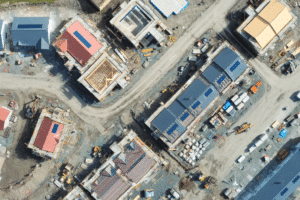
Successive governors, Senate presidents and House speakers have failed to make sure that Greater Boston’s two biggest unbuilt housing development sites, Devens and Southfield, fulfilled their potential. iStock photo.
Let me tell you a story about the time we could have made a big dent in our housing crisis almost before it started.
It was the early 2000s, and home prices and rents were starting to take off as residential construction slumped to anemic levels across Greater Boston.
A wide-ranging coalition of nonprofit groups, business groups and local religious and civic leaders called for construction of more housing, especially affordable rental units.
However, as anxiety over the housing shortage grew, two seemingly remarkable opportunities to make a dent in Boston-area’s housing shortage fortuitously appeared: recently decommissioned Fort Devens, on the Ayer-Shirley Line, and the former South Weymouth Naval Air Station, both rendered redundant by the seeming end of the Cold War.
With nearly 5,500 acres at the two former bases, there was enough land for enough new houses, condominiums and apartments to fill two, fairly sizable new towns with commuter rail and highway access.
Given that Massachusetts lacks the wide-open spaces that have made Texas a home builders dream, it was a historic opportunity in one of the most densely populated states in the country.
And we blew it.
75 Homes Per Year
Sure, Devens has become a major commercial hub since it was decommissioned, attracting giants like Bristol Myers Squibb and even a major fusion research center to its 4,000-acre spread near Interstate 495.
But housing development at Devens has been limited to the renovation of some older homes once reserved for officers and a handful of new units, with the total number capped by legislation at 282.
A proposal to convert the old Vicksburg Square barracks into several hundred new apartments, including a number that would have been reserved for veterans, went nowhere amid NIMBY opposition in the towns that control Devens, namely Harvard, Ayer and Shirley.
Add in the 1,275 units built at Southfield so far, and you have just over 1,500 new homes of all types built or renovated over two decades.
That’s about 75 new homes a year.
Given we need another 200,000 housing units of all types, that’s not even enough to keep up with current demand, let alone make a dent in that shortfall. But it’s certainly more than enough to make you angry.
What went wrong?
The same thing that has stymied desperately needed residential construction in towns and suburbs across Massachusetts for decades now: local control run amok.
Local Control Run Amok
While MassDevelopment runs Devens, in order to add more residential units, it must win approval from Town Meetings in Harvard, Shirley and Ayer.
And those voters, like so many of their counterparts in communities across the state, cited the usual litany of concerns – increased school costs and an influx of those dreaded renters – to kill efforts to develop hundreds of apartments, including a large affordable contingent, at Devens.
The large measure of control exerted by Abington, Rockland and Weymouth over successive redevelopment authorities that control their old airbase has also arguably helped put a damper on any hopes of large-scale housing development at the old base, although financial hijinks by the fourth development team to try its luck didn’t help matters.
A fifth team of real estate firms is now poised to give the site, now re-christened “Southfield,” another shot with dreams of up to 8 million square feet of commercial space and 3,855 residential units.
No One Stood Up
We live in a home rule state. Local communities have wielded veto power over pretty much any and all housing development in their borders for generations now.
But incredibly, local officials even managed to extend their sway to a pair of decommissioned military bases that had been the province of the federal government for decades.
Multiple governors and the state legislature should have put their feet down. They should have insisted that state government be the one ultimately calling the shots when it came to the redevelopment of Devens and Southfield, with local officials limited to an advisory role.

Scott Van Voorhis
Instead, a procession of governors and House and Senate leaders played the old go-along-to-get-along game, ceding authority to local select boards and town meeting voters over an unprecedented housing and economic development opportunity.
It was weak, it was spineless, and current and future generations of home buyers, owners and renters will be stuck paying the price for the squandering of an opportunity of the likes Massachusetts will likely never be seen again.
Scott Van Voorhis is Banker & Tradesman’s columnist; opinions expressed are his own. He may be reached at sbvanvoorhis@hotmail.com.




